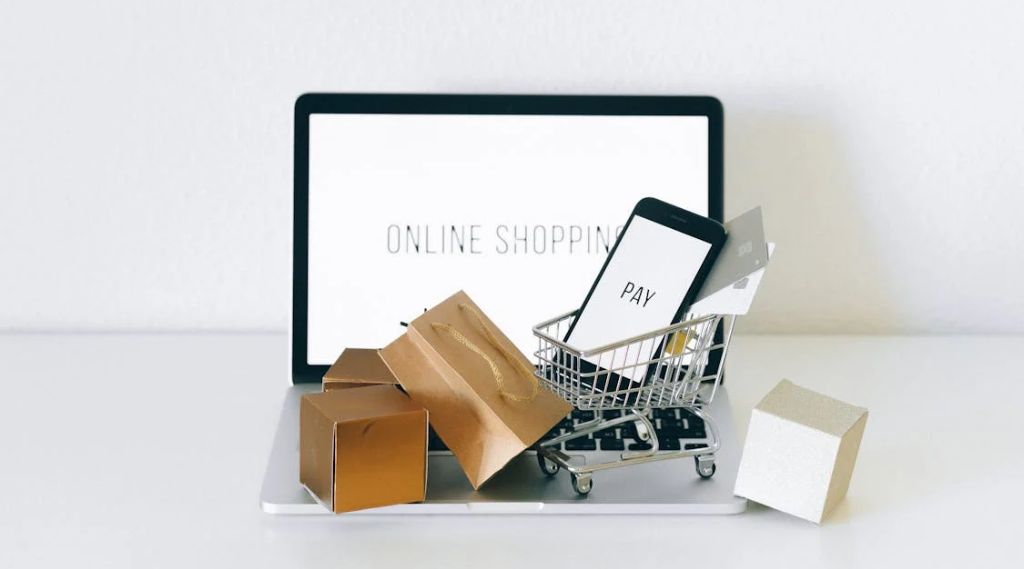This guide seeks to establish a solid base for initiating and developing an e-commerce site in 2024, and at the same time, it aims to inspire innovation and forward-thinking in the management of online ventures.
For an E-commerce businesses need to be online because it lets them offer a great shopping experience to every customer. People really like this new way of shopping because they can look at and buy products without leaving their home. This change has made shopping completely different and better for customers.

Design Your E-Commerce Website
From the moment your customers visit your site to the point of making a purchase, their online experience should be seamless and enjoyable. Follow this step-by-step guide to build a e-commerce website that ensures just that.
1. Identifying Your Online Business Type
Think about your business. Are you moving from a physical store to online? What do you sell and who wants to buy it? Here’s a simple way to see your business type:
– Selling directly to people? That’s B2C, or business-to-consumer.
– Selling to other businesses? That’s B2B, or business-to-business.
– If people sell to each other online, like in an online marketplace, that’s C2C, or consumer-to-consumer.
– When people sell their own products or services to businesses, it’s called C2B, or consumer-to-business.
2. Choosing the Right E-Commerce Platform
Next, choose a hosting e-commerce platform. Consider these three widely used website builders:
- Shopify : Very popular and easy, great for selling on your site and social media. Shopify login
- Wix : Wix is a user-friendly website builder with drag-and-drop functionality and a wide range of customizable templates. For e-commerce capabilities, you’ll need a premium plan, which includes order tracking, selling across different channels, and additional tools. Wix login
- BigCommerce : Good for big companies, It supports advanced features like SEO tools and the ability to sell internationally. BigCommerce Login
3. Customize Your Website
Start making your website your own by picking a design template. The style, colors, and fonts you choose can really affect how people feel about your site. If you want it to look very professional, you might think about hiring someone who specializes in making websites, but this can be expensive.
Initially, outline your e-commerce site, including:
– The main page people see first
– Pages that show different categories and products
– A shopping cart and checkout area
– An “About Us” page to tell people about your business
– How to contact you
– A search feature
– A place to sign up for emails
– Legal stuff like terms of use and privacy policy
Take a look at other websites for ideas. When you’re ready, start playing with the design tools to make your online store. Make sure it’s easy for people to find their way around, sign up, and buy things.
4. Establish Your Online Shop
Now, add your products with high-quality images and brand-reflective descriptions. Organize a wide range into categories by color, design, or type. Offer sorting options by price, newness, or popularity.
For your launch, set up shipping and payment for smooth transactions. Ensure online inventory matches actual stock. Connect payments to your business account. Use platforms like Shopify or services like Square or Stripe for payment processing.
5. Get Your Website Live
After finalizing your site, it’s launch time! Engage in digital marketing to attract customers. Post your products on social media. This is your moment to showcase your creations. Boost your launch with sponsored ads to reach your audience. Use Google and Facebook Ads for initial exposure. Build a following with content marketing, such as newsletters.
Guidelines for E-commerce Website Success
Companies that make their e-commerce website easy and nice to use will do well and keep their customers happy. As shopping online keeps changing, businesses that keep up with new ideas and make shopping personal for each customer will stand out and keep their customers interested.

The rise of e-commerce website has changed how the new generation lives. Now, people don’t want to spend time going out to shop because they can find everything they need with just a click online.
For a successful e-commerce website, follow these key tips:
- To succeed in your online e-commerce business, prioritize putting your customers first. Show them they are valued above everything else.
- Make sure your e-commerce website adjusts smoothly to any device to enhance user comfort.
- Offer a variety of delivery options to meet different needs and preferences. From standard to express shipping, flexibility can be a decisive factor for customers making a purchase.
- Invest in quality customer service. Providing multiple channels for support, such as live chat, email, and phone, ensures customers can easily get help when they need it.
- Gather and act on customer feedback. Regularly collecting customer opinions and making adjustments based on their input demonstrates your commitment to their satisfaction.
- Ensure your e-commerce website is secure and complies with privacy regulations. Trust badges, secure payment gateways, and transparent privacy policies can further reassure customers about their data’s safety.
- Stay active on social media to build a community around your brand. Engaging with customers on these platforms can enhance your brand’s visibility and foster a sense of loyalty.
- Implement a hassle-free return policy. Making returns easy and straightforward reassures customers, making them more likely to buy with confidence.
Think about how you’ll get your products to customers, if you have them:
– Direct-to-Consumer (D2C): You sell your products directly to customers, bypassing wholesalers and retailers.
– Drop Shipping: You create a website where customers can order products, which are then directly shipped from the supplier who handles the inventory and packaging. This business model is quick and affordable to start.
– Wholesaling: You buy products in large quantities at a discount from a manufacturer.
– White Label: You purchase a generic product from a distributor and rebrand it as your own.
– Private Label: You commission a manufacturer to produce a unique product for your brand alone.
– Subscription: You offer a service that delivers products, like pet food or boxes of fresh vegetables, to customers on a regular, recurring basis, catering to those who value convenience.





